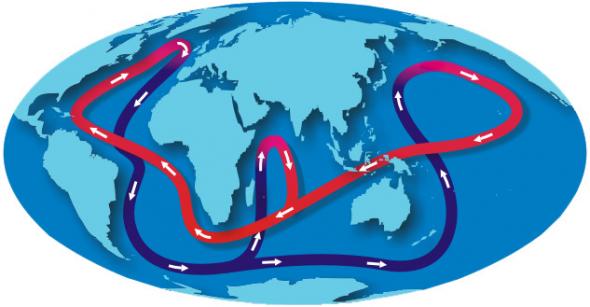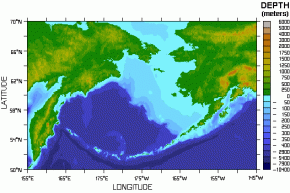Image caption
SF Fig. 2.9. In this model of the Global Conveyor Belt, warmer ocean surface currents (in red) and colder bottom currents (in dark blue) are interconnected. This is a very simplified model of global ocean circulation.
Image copyright and source
Image courtesy of the National Oceanic and Atmospheric Administration (NOAA)
The ocean plays a large role in regulating climate at both a regional and global scale because of its ability to store heat, which is greater than that of land. The processes of wind driven surface currents, cold bottom water formation through density effects, and equatorial mixing are commonly referred to as global thermohaline circulation. Through global thermohaline circulation, heat is transported from the tropics to the poles through surface currents and then cold water is transported back to the equator. By connecting ocean currents, scientists have some evidence to support what is known as the Global Conveyor Belt (SF Fig 2.9).
Bottom Water Currents
SF Fig. 2.10. This topographical map of the Bering Strait shows it is very shallow compared to the Pacific ocean basin. The shallow shelf of the strait prevents cool dense seawater from sinking into the Pacific ocean basin.
The formation of dense bottom water near the poles forms a cold layer of ocean water on the ocean floor. Bottom water is constantly being replenished at the poles, while it flows slowly towards the equator. The North Atlantic Deep Water is an example of a bottom water current in the Atlantic ocean basin. Dense water forms and sinks in the Arctic ocean basin and flows southward between Greenland and Europe into the Atlantic ocean basin. Near the South Pole, cold dense water forms near Antarctica creating Antarctic Bottom Water. Because there are no continents to act as barriers, Antarctic Bottom Water flows into all ocean basins. A bottom water current does not form in the Northern Pacific ocean basin because the shallow Bering Strait between Alaska and Russia, which is between 30 and 50m deep, effectively acts like a barrier (SF Fig 2.10).
Equatorial Mixing
Image caption
SF Fig. 2.11. Diagram showing equatorial upwelling and mixing of cool bottom water with warm surface water. Warm surface water is returned to poles through wind-driven surface currents. This is a very simplified model of water circulation in the Atlantic ocean basin.
Image copyright and source
Surface currents driven by wind, especially those on western boundaries of ocean basins, explain how heat can be transported from the equator to the poles. Thermohaline circulation, through cold bottom water formation, explains how cool water moves back to the equator by traveling along the ocean floor. Two processes contribute to mixing of cold bottom water and warm surface water near the equator. The first is tidal mixing. Tides are shallow water waves with very large wavelengths. As tidal waves come into contact with continents and mid-ocean ridges they can cause mixing. The second process that contributes to the mixing of bottom water and surface water is upwelling. Trade winds in the northern and southern hemisphere cause surface currents that flow away from the equator, creating a zone of equatorial upwelling (SF Fig 2.11).
The Global Conveyor Belt as a Model
The Global Conveyor Belt serves as a model for the mechanism of how heat is transported throughout the ocean. Global thermohaline circulation is a relatively slow process. Radiocarbon measurements show that deep water in the ocean is replaced by new bottom water only every 600 years. Although slow, global thermohaline circulation is important because of the large amount of upper ocean water converted into deep bottom water, approximately 15,000,000 cubic meters per second (m3/s) in the Atlantic ocean basin. As a comparison, all the rivers in the world combined deliver about 1,000,000 (m3/s) of fresh water into the ocean. Although the motion of water in the ocean is complex and affected by many different factors, scientists can use the global conveyor belt model to help make predictions about global ocean circulation.
Climate Change and Global Thermohaline Circulation
The Intergovernmental Panel on Climate Change (IPCC) reports that between 1906 and 2005 the global average temperature has increased by 0.74ЛљC and that it is predicted to continue increasing. Although there is very little research or evidence on the extent of the connection between climate and global thermohaline circulation, some predictions have been made. There is some evidence to suggest that an increase in global temperature may reduce the amount of sea ice formation. A decrease in the amount of sea ice formation would reduce the formation of bottom water. Because of the importance of bottom water in global thermohaline circulation, heat transport to the poles from the equator would decrease if thermohaline circulation slowed or stopped. Polar regions would get colder because they would not be receiving as much heat.
For example, according to IPCC reports, scientists predict that in the Atlantic ocean basin, thermohaline circulation will slow over the course of the 21st century. If the Atlantic ocean basin thermohaline circulation were to stop, the climate in western Europe could be affected. With the reduction in warm surface water flowing from the tropics, westerly winds that normally account for Europe’s mild climate would pick up less heat as they travel over the ocean, resulting in a cooler Europe. However, the IPCC reports that it is unlikely that thermohaline circulation would abruptly stop, and there is currently no indication that a shutdown of thermohaline circulation is occurring. Furthermore, regional warming due to an increased greenhouse effect would likely initially cancel out the effects of cool westerly winds.










